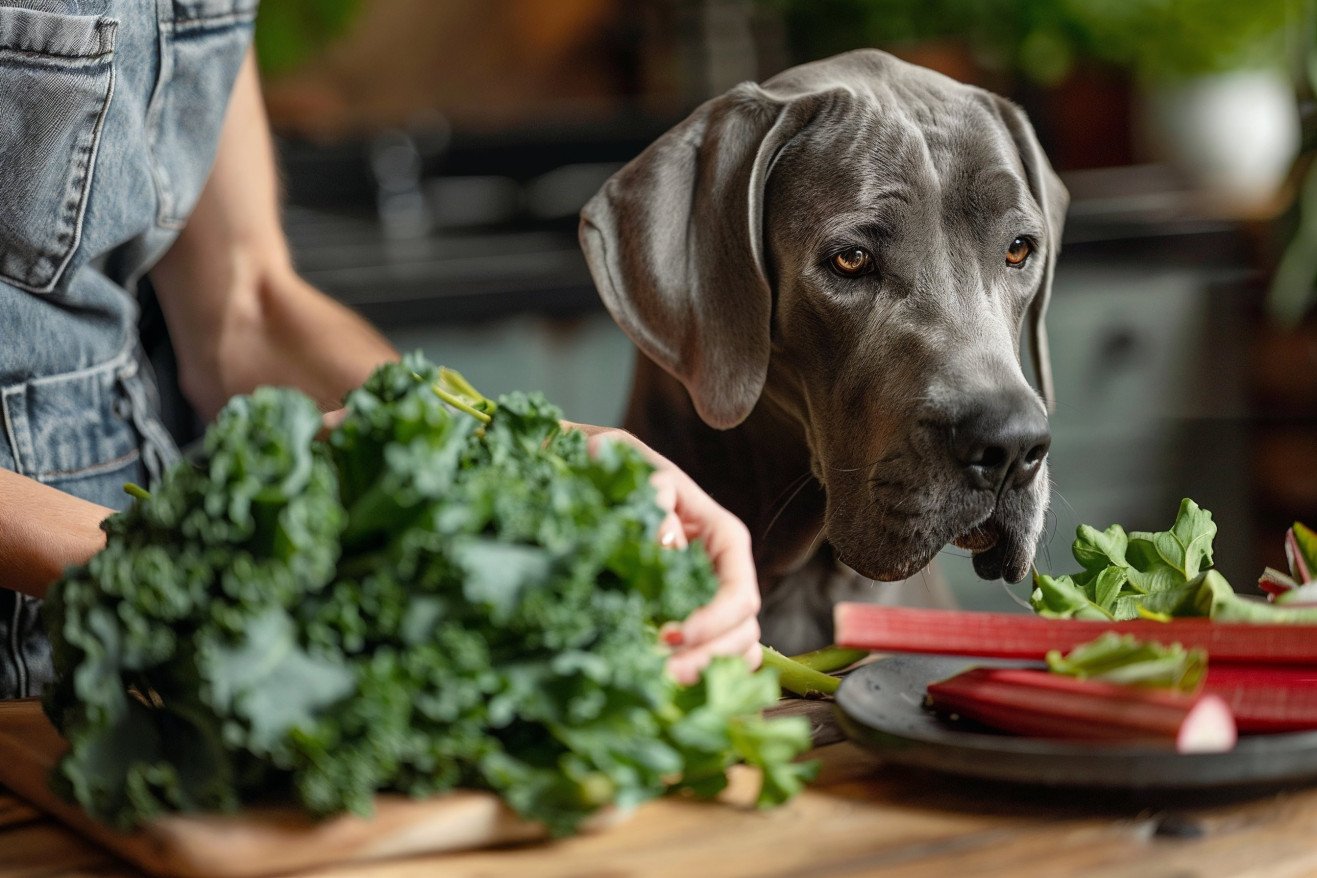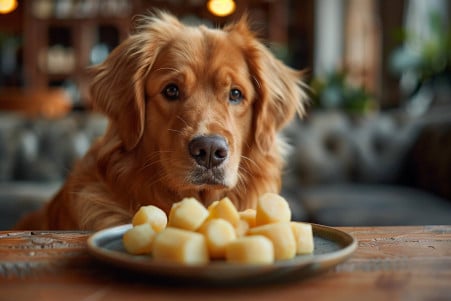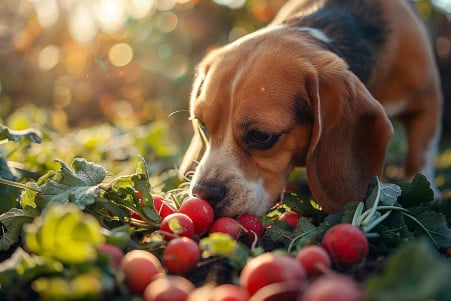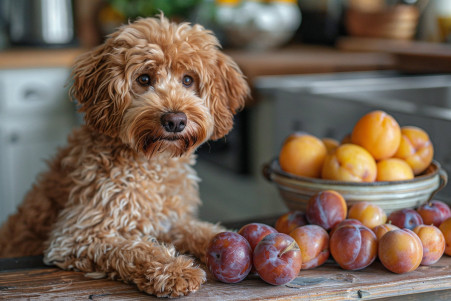Can Dogs Eat Rhubarb? Potential Risks and Benefits
7 June 2024 • Updated 5 June 2024

Despite its nutritional value, there are some important safety issues to be aware of before you decide to share this vegetable with your dog. Rhubarb is toxic to dogs because it contains oxalates, which can cause kidney failure and other health issues. The leaves have a higher concentration of oxalates and are even more toxic. As a result, it's best to avoid giving rhubarb to your dog and opt for other fruits and vegetables instead.
To better understand the potential risks and benefits of dogs eating rhubarb, we'll look at studies conducted by veterinary toxicologists, pet nutritionists, and animal behaviorists. Their research explains the chemical properties that make rhubarb a problem for dogs and offers suggestions for other options that can help satisfy a dog's desire for a fresh, crunchy snack.
Can dogs eat rhubarb?
What Makes Rhubarb Toxic to Dogs?
Rhubarb is toxic to dogs due to its high levels of soluble oxalate crystals. According to the Pet Poison Helpline, when ingested, these oxalates bind to calcium in the body, leading to a rapid and severe decrease in calcium levels. The leaves of the rhubarb plant are particularly high in these oxalate crystals, which is why dogs are especially at risk if they eat them.
In addition to the symptoms of drooling, loss of appetite, weakness, tremors, and changes in thirst and urination, that can result from eating rhubarb, the oxalates also cause direct irritation to the mouth, gastrointestinal tract, kidneys, and bladder, which can lead to significant pain and distress. In severe cases, the consumption of large amounts of rhubarb can lead to acute renal failure and death, according to a study on WagWalking.com.
Veterinary toxicologists explain that soluble oxalates, once they're absorbed into the bloodstream, form crystals that can be deposited throughout the body, causing organ damage and vessel blockages. This is the process, which is detailed by sites like the PetPoisonHelpline.com, that makes rhubarb so dangerous to dogs in comparison to plants that contain insoluble oxalates. Because of its potential to lead to kidney failure, the ingestion of rhubarb needs to be treated as a medical emergency to prevent potentially fatal complications.
How to Tell If Your Dog Has Eaten Rhubarb
Vomiting, diarrhea, drooling, and difficulty swallowing are all signs of rhubarb poisoning in dogs, according to Designer Dog Foods. In more severe cases, dogs may experience lethargy, tremors, seizures, and other neurological symptoms due to the impact of oxalic acid on the central nervous system, as reported by Indian Rhubarb is Toxic To Dogs.
Dogs may also show signs of kidney damage, including changes in urination like blood in the urine, as a result of oxalate toxicity, according to the ASPCA. Dehydration can also occur if vomiting and diarrhea are not treated, which can make the dog's condition even worse. Veterinarians stress the importance of getting professional help as soon as possible, as waiting can make the symptoms worse and increase the likelihood of complications.
Emergency Response: First Aid and Veterinary Treatment for Rhubarb Poisoning
If a dog has eaten rhubarb, first aid measures include mouth rinsing and soothing treats, but do not induce vomiting unless instructed to do so by a vet, says Pure Pet Food. Immediate veterinary attention is needed, with treatments that can include IV fluids, pain medications, antihistamines, and gastroprotectants being administered based on the dog's symptoms, says Indian Rhubarb is Toxic To Dogs.
Vets may also suggest checking kidney function and providing supportive treatments to help with symptoms and prevent issues. In cases of rhubarb poisoning that are more serious, the dog may need to be hospitalized and treated for organ failure and other severe symptoms, according to Rhubarb is Toxic To Dogs. It's important to act fast to ensure the best chance of the dog recovering and avoiding long-term health issues.
How to Avoid Rhubarb Poisoning: Tips for Protecting Dogs
To avoid the risk of rhubarb poisoning in dogs, gardeners should take steps to protect their plants. As noted by Gardening Know How, planting rhubarb in raised beds or separate garden areas can help keep dogs from accidentally eating the plants. In addition, fencing, mulch barriers, and planting thorny plants around the rhubarb can help keep dogs away.
For added protection, Rhubarb is Toxic To Dogs suggests using commercial or homemade scent repellents, such as ammonia, vinegar, or pepper, around the rhubarb. Motion-activated sprinklers and decoys with LED lights can also help keep dogs away from the area, as recommended by Gardening Know How.
It's also important to make sure that all members of the household, especially children, are aware of the risks of rhubarb to dogs and the need for supervision. By using a combination of these protective measures, pet parents can make sure their pets stay safe and healthy, even in a garden environment.
Healthy Alternatives: Fruits and Vegetables That Are Safe for Dogs
Many fruits and vegetables, including apples, bananas, blueberries, carrots, and pumpkin, are safe for dogs to eat in small amounts as an occasional treat, says WebMD. On the other hand, grapes, raisins, onions, and mushrooms are examples of fruits and vegetables that are poisonous to dogs and should be kept away from them, according to the American Kennel Club. That said, it's important to remember that dogs should only be given human food in moderation since overeating can lead to an upset stomach.
Apples, blueberries, cantaloupe, and more are examples of fruits that are safe for dogs, while bell peppers, broccoli, carrots, and spinach are examples of vegetables that are safe for dogs, according to RAWZ. By offering a selection of fruits and vegetables that are safe for dogs, dog owners can meet their furry friend's desire for fresh, crunchy snacks without the dangers associated with rhubarb.
Conclusion: Keeping Pets Safe and Encouraging a Balanced Canine Diet
Rhubarb is not safe for dogs to eat. According to MasterClass, although rhubarb has many health benefits for humans, it is toxic to dogs. The Wildest notes that rhubarb's oxalates can combine with calcium in a dog's body, causing a sudden and dangerous drop in calcium levels.
However, there are many fruits and vegetables that are safe for dogs and can be used as treats. Bananas are a great source of potassium, vitamin B6, and vitamin C for dogs. Rutabagas are a good source of vitamin C, potassium, and carotenoids, which are good for eye health and cell function. Sweet potatoes, carrots, green beans, papaya, pumpkin, blueberries, turnip greens, and chard are all great sources of vitamins and minerals for dogs.
As described by The Middle-Sized Garden, it's important to puppy-proof the garden by making sure the boundaries are secure, storing chemicals in a safe place, and keeping an eye on dogs when they are in the garden to make sure they don't eat anything that could be toxic. With the right measures in place and the right fruits and vegetables, dog owners can make sure that their pets are safe and healthy.


